
Evans Property, Waynesville, North Carolina (planted July 2008)
ABOVE RIGHT: "Celia" Torreya a week after planting.
|
ABOVE LEFT: To the left of the freshly planted specimen is a small glass bottle of a portion of Celia Hunter's cremains. Celia was Connie's conservation mentor and former board member and president of the Wilderness Society. Connie placed a few pinches of cremains in the soil around this plant. 
Celia Hunter Tree
Evans Property, Waynesville, North Carolina (planted July 2008)
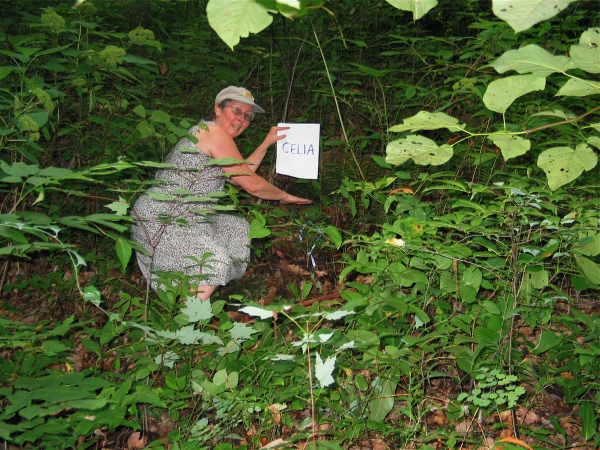
LEFT: "Celia Hunter" (#31), shown by Connie Barlow (July 31, 2008) immediately after planting. (Flash photo because full deciduous canopy over Celia.) Connie deliberately chose as an experiment "the darkest, wettest, accessible location" for planting this specimen, which she had carried with her around the country in her van for a year, after having received this potted seedling as a gift when visiting the Atlanta Botanical Garden and touring their Torreya propagation program. (Note: ABG was unaware that Connie might attempt to plant it in an "assisted migration" mode.) Because it comes from the ABG, it has a very different genotype from all the rest of the planted specimens, which are all offspring of the Norlina NC huge tree.
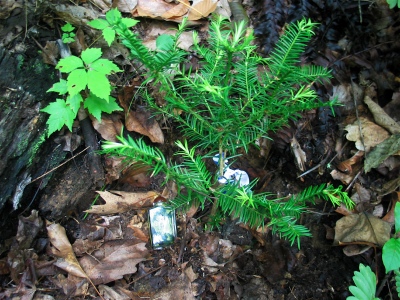
ABOVE RIGHT: "Celia" Torreya a week after planting.
Nov 08: "Celia" foreground, looking SW at seeping cliff rock
Nov 08: looking straight up from Celia. Notice barren
deciduous canopy, so excellent growth time for Celia.
Nov 08: yellow arrow at Celia
(view NW; see dying hemlock behind largest trunk)
Nov 08: view NW. Barren canopy, so Celia in full sun.
Nov 08: view N; largest trunk = Tuliptree; shrub = Rhodie
Nov 08: view South, downhill, from Celia
Nov 08: looking down on a very healthy Celia
Nov 08: distant view fr downhill; Celia at arrow well
behind 2 slim trees it is sighted between; rhodie far back
Dec 08: Evergreen "Celia" thriving after a snow.
The Celia Hunter Tree barely escaped being squashed
by a fallen branch during the winter of 08/09.
photo and assessment by Lee Barnes
June 09Despite bitter cold in December 2009,
"Celia" looks healthy in this photo
taken by Lee Barnes, early January 2010.
9/23/10: noonish on sunny day; photo from trail, uphill view.
Michael's hand is at top of tree.
9/23/10: standing at Celia; downhill view to rock wall.
(photos by Connie Barlow)
9/23/10: Hand at Celia top. Notice fallen branch.
9/23/10: close-up of tree top
9/23/10: top-down view (see central crown)
9/23/10: lovely central crown growth; new since 2008
9/23/10: view directly up above Celia.
May 2012: view from path 15 ft downslope fr. Celia
This "Celia" specimen is the only one on the west side of the Evans property that is upstream of the waterfall / weeping rock wall. It is on a very moist, steep, and jungle-like bank on the east side of the perennial creek. (3,400 feet elevation)
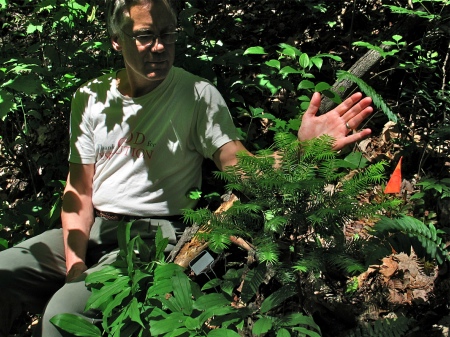
LEFT and RIGHT (May 18, 2012): Surrounding the Celia specimen are moisture-loving deciduous plants, including poison ivy, virginia creeper, false solomon seal, and especially hydrangia and black kohosh. There are also a lot of Christmas ferns, and a sword fern to the right. In early spring there are many trout lilies within a few feet. This photo was taken from the path that leads from the house to the waterfalls down below.

LEFT (May 18, 2012):As of 2012, Celia has the most luxurious and healthy growth of all of the specimens planted on the Evans property in 2008. We created the "10-point-scale" in 2012 to evaluate the quality of all the trees — and it was Celia that the "10" is calibrated to. (Note: Later that day we also photographed and assessed the 7 remaining specimens planted in 2008 at the Corneille Bryan Native Plant Garden in Lake Junaluska. There we discovered that all specimens rated higher: between an 11 and a 16.) Look carefully at the photo for light-green new growth at lateral branch tips: when the new growth is a "triplet" (rather than a doublet or a singlet), that is a sign of exceptional health.
RIGHT (May 18, 2012): View down from Celia toward the waterfall, just beyond which grows the "Maxilla Evans" specimen, which rated a 9 on the 10-point scale.
NOTE: Spring 2013 photos below taken April 24 on an overcast day, but spring was delayed nearly 2 weeks, so it is more like April 10. Thus, instead of light-green new growth photographed above in spring 2012, there is only light-green leaf buds to indicate the vigor of the plant.
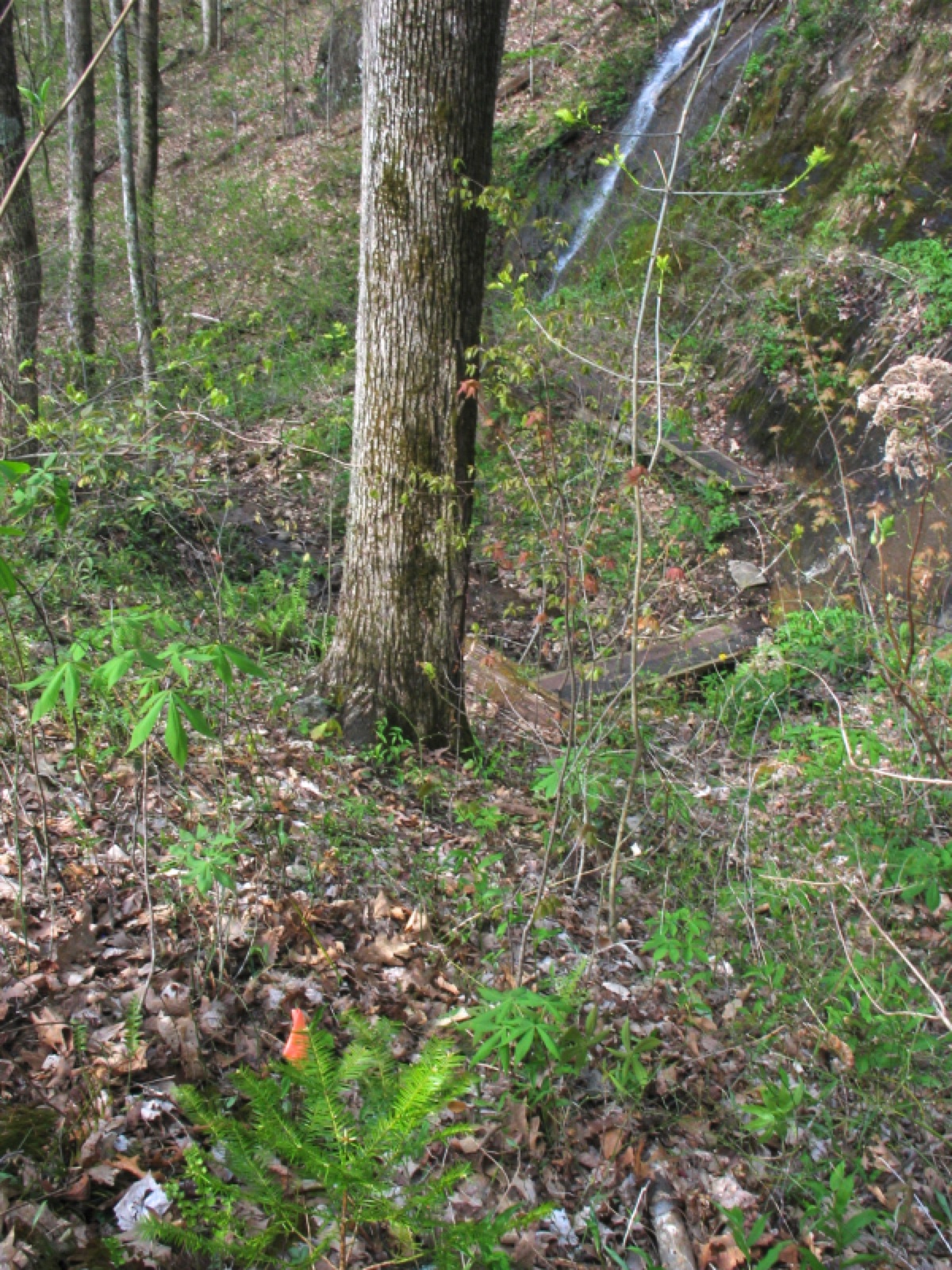
ABOVE LEFT (April 24, 2013): View downslope standing uphill from Celia (lower left by orange flag), with view down to waterfall. "Maxilla" is not visible on the distant slope left of the lowest part of waterfall.
ABOVE RIGHT (April 24, 2013): Celia, looking uphill and left. Young sword ferns and solomon seal in foreground. Notice that Celia has no ancillary basal growth, which Torreys tend to put a lot of energy into if the main stem falters.
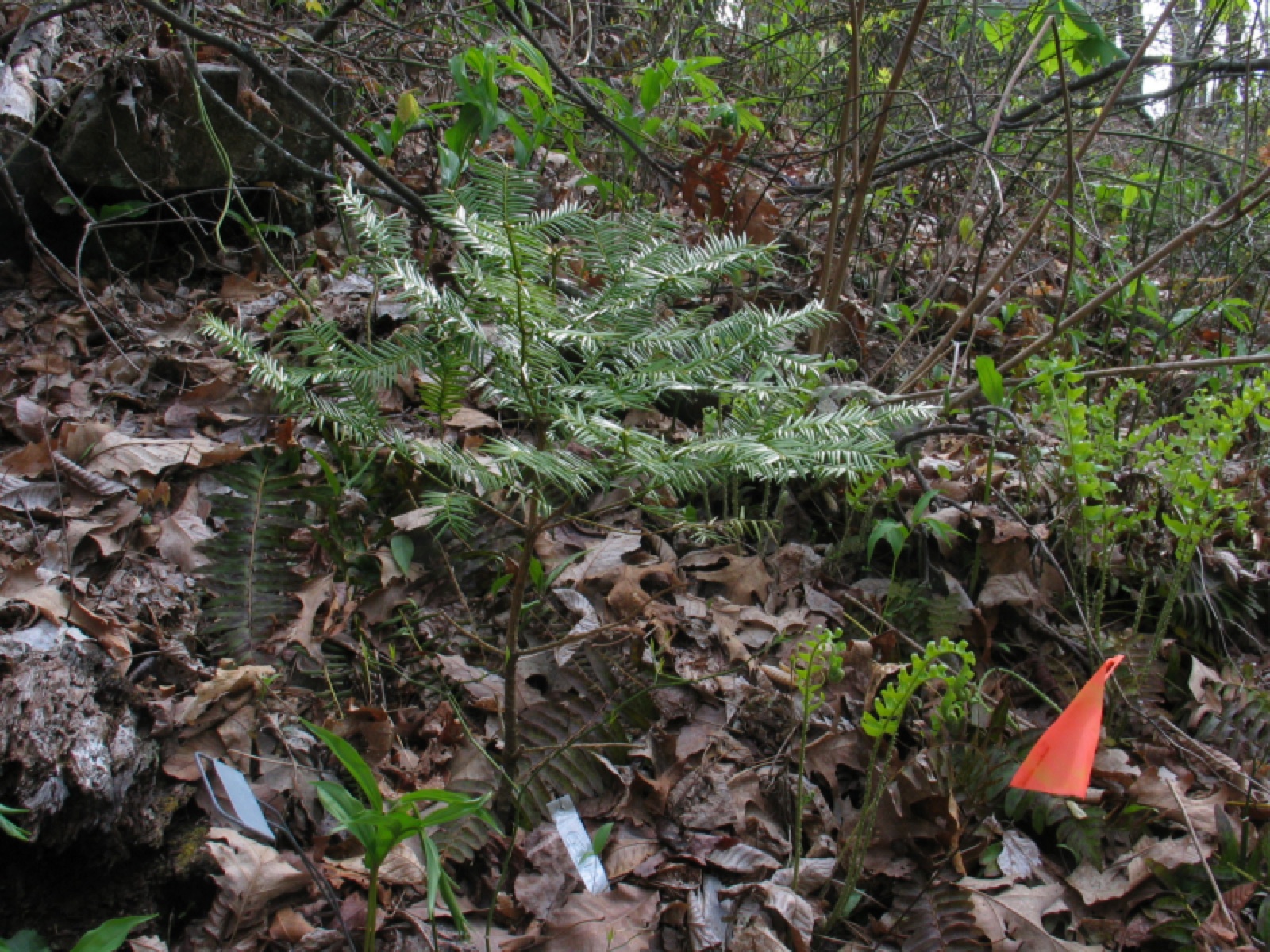
ABOVE LEFT (April 24, 2013): Notice no ancillary basal growth on Celia. And there are just 3 years of radial branches (3 layers) that constitute the entire tree (prior year branches have dropped off).
ABOVE RIGHT (April 24, 2013): 2012 and 2011 vertical stem growth visible, each about 3-4 inches per year. The 2010 vertical main stem growth is also 3-4 inches, but is below the level of this photo.
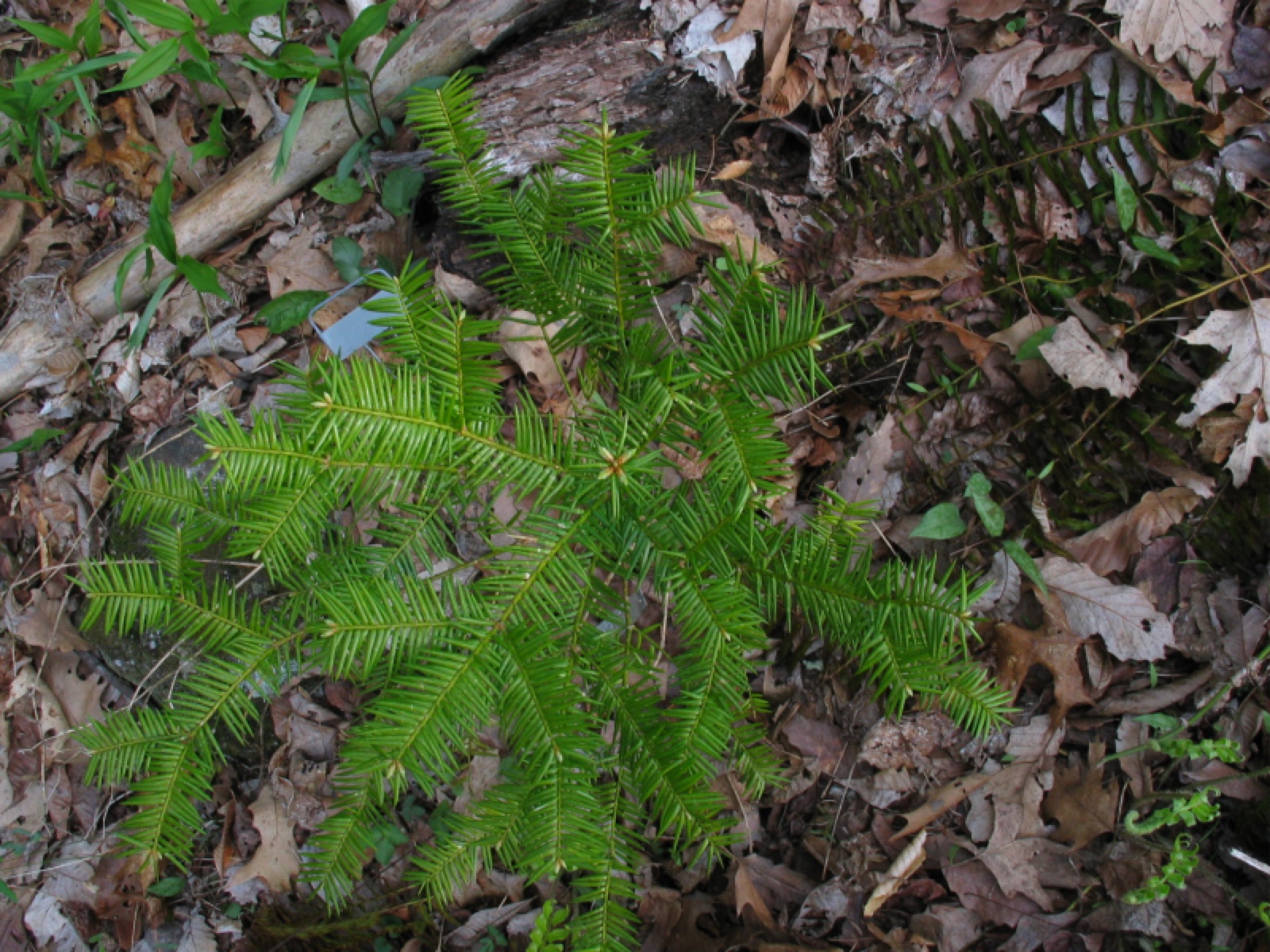
ABOVE LEFT and RIGHT (April 24, 2013): Top-down view of Celia. All three layers (all three years) show 4-part branching, whereas some other specimens tend to produce 5 or even 6 radiating lateral branches from the central stem. Notice at right that the new leaf buds at tip are a single small apical bud with 4 radiating laterals.
NEW MEASURE OF HEALTH IN 2013: leaf bud count = 51 on main stem; 0 on (absent) basal ancillary growth
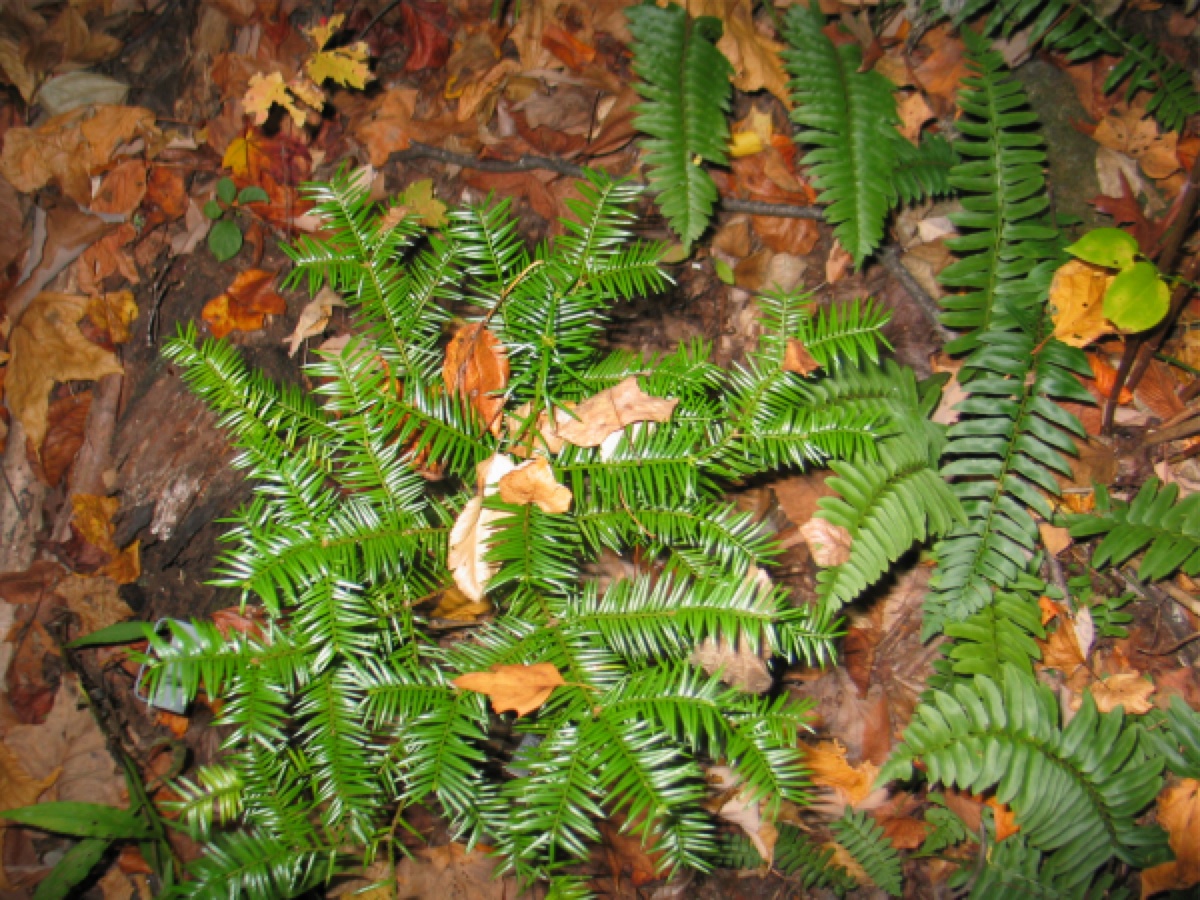
ABOVE LEFT and RIGHT (October 28, 2013): Healthy new vertical growth and overall horizontal photosynthetic capacity is evident in these 2 photos. (photos by Connie Barlow)
CELIA is the last tree (no. 31) planted at the Evans Property in 2008. Click here to BEGIN VIEWING TREE NUMBER 11, first tree planted at Evans Property, Waynesville.
Click here to return to EVANS PROPERTY IN WAYNESVILLE PLANTING.
Click here to return to MAIN PAGE OF TORREYA REWILDING PHOTOESSAY.